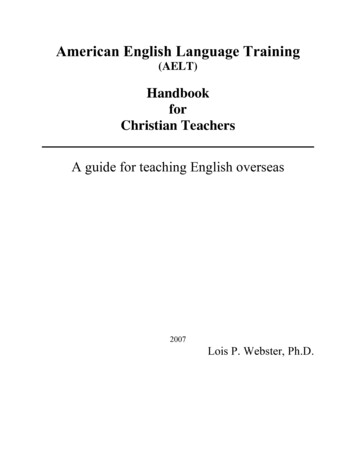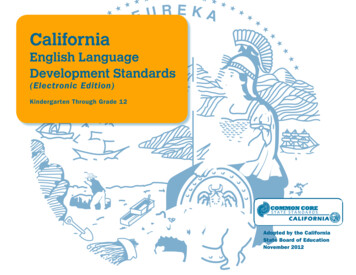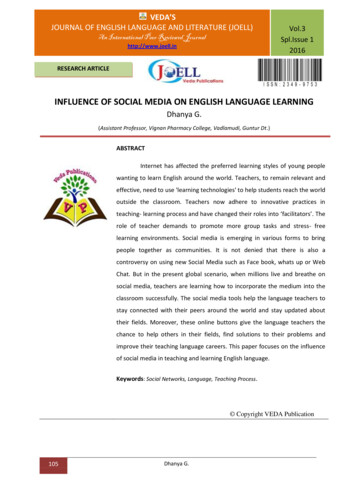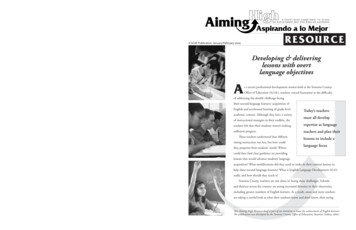
Transcription
American English Language Training(AELT)HandbookforChristian TeachersA guide for teaching English overseas2007Lois P. Webster, Ph.D.
American English Language Training(AELT)HandbookforChristian TeachersA guidefor teaching EnglishoverseasLois P. Webster, Ph.D.Director of English Studies2007Association for Christian Conferences, Teaching, and ServiceP.O. Box 27239Denver, CO 80227-0239U.S.A.www.ACCTS.org
Contents in BriefUnit 1Foundation of AELT 11Teaching English to Speakers of Other Languages 32Language Learning and Teaching 7Unit 2The Sub-Systems of Language 153Pronunciation 174Vocabulary 255Grammar 33Unit 3Developing Conversational Skills 396Teaching Tools for Conveying Meaning 41i
7Facilitating Listening Comprehension Skills 498Facilitating Speaking through Guided Exercises 619Speaking Freely 71Unit 4Working with Students 8110Placement Procedures 8311Working with Different Levels of Students 9312Planning 10513Correcting Students 115Additional ResourcesAppendicesii125123
ContentsAbout the AuthorviiFoundations of AELT1Unit 1Teaching English to Speakers of Other Languages3Chapter 1American English Language TrainingThe AELT Curriculum45Language Learning and Teaching7AELT Is An EFL ProgramThe Nature of LanguageUnderstanding What Is HeardThe Way Language SoundsVocabularyStructureSocial UsageThe AELT LearnerAptitudeMotivationKnowledge of EnglishOpportunities to LearnUse of Students’ Native Language in the AELT ClassroomThe Nature of AELT TeachingTeacher as ModelPrinciples of Good Modeling78889910101111111112121313The Sub Systems Of Language15Unit 2Pronunciation17Chapter 3What Influences PronunciationVoicingMouth, Tongue, and Lip PositionStress, Rhythm, and IntonationDifficulties with Learning English PronunciationThe Influence of the Student’s Native LanguageCorrecting Students’ PronunciationTeaching PronunciationActivities for Developing Good Speech HabitsMinimal PairsTongue Twisters1818181820202122232323Chapter 2iii
Chapter 4Chapter 5Unit 3Chapter 6Chapter 7ivVocabulary25MeaningContent Words and Structure WordsConcrete and Abstract MeaningConnotative and Denotative MeaningTeaching VocabularyTeach Vocabulary in ContextIdiomsPhrasal VerbsDifficulties with Learning English Vocabulary252525262626282931Grammar33What is Grammar?Sentence StructureTeaching Sentence StructureDifficulties with Learning English GrammarEnglish PrepositionsEnglish ArticlesThe Position of AdjectivesGrammatical Gender3334353737383838Developing Conversational Skills39Teaching Tools for Conveying Meaning41Conveying MeaningVisual MaterialsReal ObjectsMapsNewspaper AdsMenusSimple Drawings and Home Made ThingActionsPicturesWhere to Obtain PicturesHow to Prepare Pictures and Other Colorful Visuals4141424343444445454647Facilitating Listening Comprehension Skills49Total Physical Response (TPR)TPR for the Beginning LearnerThe Characteristics of TPRFive Steps in Facilitating TPRTeaching TPR with Colored PaperUsing Colored Paper for Teaching TPR with More Advanced StudentsChecking ComprehensionRequesting Action to Follow DirectionsInteracting Listening and SpeakingQuestions That Require Answers49495051535555565657
Facilitating Speaking Through Guided Exercises61Chapter 8DrillingBackward Buildup DrillRepetition DrillsOpen-Ended Chain DrillsSubstitution DrillsResponse DrillsTransformation Drills61626364656769Speaking Freely71Using Games in the ClassroomCreating and/or Using Games Already AvailableSuggestions for Choosing or Creating GamesSuggestions for Playing the GameRole PlayingWhy Role Play?Three Types of Role PlaysHow to Create Role PlaysDialogueKinds of DialoguesMemorized DialoguesCued DialoguesHow to Facilitate the Learning of Dialogues71727273747474757576767777Working with Students81Unit 4Placement Procedures83Chapter 10The Needed InformationListening Comprehension AbilityProduction SkillsGathering the InformationThe InterviewProblem Areas to Be ConsideredProblems with the Placement ProcessProblems Following Initial PlacementModifications to Initial PlacementDealing with LatecomersPlanning for the Placement Process8383848585878788898989Planning for Different Levels of Students93Beginner1 StudentsDescriptionGoalsTeaching StrategiesBeginner2 StudentsDescriptionGoalsTeaching Strategies9393939495959696Chapter 9Chapter 11v
Chapter 12Chapter 13Intermediate StudentsDescriptionGoalsTeaching StrategiesLow Advanced StudentsDescriptionGoalsTeaching StrategiesAdvanced StudentsDescriptionGoalsTeaching 105Lesson PlanningActivitiesProceduresThe Function of the Interpreter in a Conversational English ClassCreating a Plan for the First Day of Class106109111111112Making Corrections115Correcting Student BehaviorCorrecting English MistakesIs it a Mistake—British Versus American English?How about Dialect?Correct Gently and NeedfullyWhen Should Errors Be Corrected?When Should Errors Not Be Corrected?Which Errors to CorrectError Correction Techniques115116117118118119119119119Additional s for Developing Listening Comprehension SkillsActivities for Developing Vocabulary SkillsActivities for Developing Grammar SkillsActivities for Teaching Conversational PhrasesInteractive Listening-Speaking ActivitiesActivities for Developing Conversational SkillsDialoguesPlacementRole PlaysTongue TwistersTwo-Word VerbsDrillsVocabulary Lists with IdiomsSample Lesson Plan, Beginning Level127131137139141143145147151155157161169199
About the AuthorLois P. Webster has an earned Doctor of Philosophy in ReadingEducation with a minor in both Linguistics and Adult Education fromIndiana University; a Master of Arts in Reading Education and AdultEducation from San Francisco University; and a Master of Arts forTeachers in Teaching English as a Second Language from IndianaUniversity.Dr. Webster has had extensive experience in teaching, training, andadministering English as a Second Language since 1970. Her experiencealso includes being a professor of education at the University ofTennessee at Chattanooga, at Indiana Wesleyan University, Marion,Indiana, and at Taylor University at Ft. Wayne, Indiana. She has hadadministrative experience in higher education to include academic dean,dean of continuing education, division chair, and department chair ofeducation.vii
viii
Unit1Foundation of AELT1Teaching English to Speakersof Other LanguagesAmerican English Language TrainingThe AELT Curriculum: The English Curriculum; The Bible Study Curriculum2Language Learning and TeachingAELT Is An EFL ProgramThe Nature of Language: Understanding What Is Heard; The Way Language Sounds;Vocabulary; Structure; Social UsageThe AELT Learner: Aptitude; Motivation; Knowledge of English; Opportunities toLearnUse of the Students’ Native Language in the AELT ClassroomThe Nature of AELT Teaching: Teacher as Model; Principles of Good Modeling1
2
Chapter1Teaching English to Speakersof Other LanguagesWelcome to the exciting world of Englishlanguage learning! Exciting, you say? YES. Teaching a person the basic skills of English is an enjoyable, satisfying ministry, towhich God has called you as His child.The adventure of Christian living is serving God. Jesus said, “Mypurpose is to give life in all its fullness” (John 10:10 New LivingTranslation [NLT]). For Christians seeking to serve our Lord, anEnglish language ministry is a wonderful and rewarding outreach because it is a relational ministry – a people-to-people mission. You areinvolved with a missions ministry where English builds the neededbridge of communication and culture.Welcome tothe excitingworld of theAmericanEnglish Language Training (AELT)ministry.The Latin origin of the word “priest” in the New Testament, means“bridge builder.” As Christians, Peter states “. . . You are a chosenpeople. You are a kingdom of priests, God’s holy nation, his very ownpossession. This is so you can show others the goodness of God, . . . ”(I Peter 2:9 NLT). As God’s priest you are a bridge-builder bringingpeople into the knowledge of God’s love and grace through the medium of teaching English. The most important gift you can give yourstudents is His love and grace through your presence in the classroom.As you begin teaching your learners . . .Remember – Teaching English does not mean you have to have yearsof special linguistics training. It is for students who want to know howto use the basic conversational English skills needed in everyday life.Remember – Teaching English as an evangelistic outreach is accomplished by providing a Christian environment during your classes. Itdoes not mean you have to possess the gift of evangelism. You fulfillPaul’s admonition to Timothy to “. . . Complete the ministry God hasgiven you” (II Peter 4:5 NLT).Remember – Teaching English allows you to see genuine, lastingprogress with students over a short period of time.3
Remember – Teaching English to grateful learners will expose you toother customs and cultures which will broaden your Christian life andworldview.Increasingly, churches are seeing the need to send missionariesoverseas and to train and equip volunteers in their congregations forthis ministry. Those committed to the “fulfillment of the Great Commission” in Cambodia, Ukraine, Central and South America, Madagascar, and other parts of the world, are helping win these countries toChrist by doing a ministry. It is our prayer that believers, who havesat languid in pews week after week, will breathe deeply the freshwind of world missions and capture a renewed vision of being a part ofGod’s great plan – “Go into all the world . . .”American English Language Training (AELT)Globalization has developed in an unprecedented manner. American English has emerged as the dominant language in globalization.The result is a great demand for learning American English conversational skills.Military Christian leaders also need English language skills in thisnew world. The Military Christian Fellowship (MCF) of Ukraine recognized this need some years ago and felt that the provision of conversational English language skills could help Christian leaders grow anddevelop and help them reach out to others with the Gospel. The Association for Christian Conferences, Teaching and Service (ACCTS),with its mission of assisting in the development of Christian leaders inthe Armed Forces of the world, and in the establishment and growth ofMilitary Christian Fellowships (MCFs), responded in 2001 to this needby offering English conversational skills at a week-long English Campin Ukraine.The American English Language Training (AELT) program ofACCTS has grown out of this initial experience. This Program provides English language conversational skills instruction for personswho are beginners in the language or will build on any English skillsindividuals already have by helping them to speak American Englishbetter. AELT helps carry out the mission of ACCTS through this Program, the purpose of which is to assist in the establishment or growthof MCFs and reach out with the Gospel in that nation.As the demand for English programs among MCFs has grown, ithas become necessary to formalize training in order to establish andrun English programs successfully. This AELT Teacher Handbookhas been developed to meet that need. It provides a description of theAELT program and an understanding of how a foreign language islearned and the “how to’s” of teaching English to speakers of otherlanguages so as to give teachers a foundation in providing instruction for their classes.The general purpose of the AELT program is to assist in the4
establishment and growth of Military Christian Fellowships (MCFs)and in reaching out with the Gospel to the nations of the world.The AELT CurriculumThe AELT program, which is presented only to military organizations, is composed of two skill/study areas. It can be adapted to meetthe needs of each MCF and all levels of English competency represented by students. The Curriculum can provide both English skillsand Bible Studies. On the other hand, the curriculum can be Englishonly training, depending on the request of the host.The English Curriculuma. American English conversational skills – the ability tocarry on a conversation in English with other speakers ofEnglish -- is the focus of AELT instruction. Instructorswill model the English language in such a way that studentshear and practice the language without the use of textbooksor other learning materials.b. Most English language courses place great emphasis onbook learning – vocabulary, grammar, and the ability toread English. However, experience has shown that this approach does not ensure English speaking skills.c. English is taught without interpreters at three English competency levels – Beginner, Intermediate, Advanced -- depending on the needs of the local MCF. Student levels aredetermined by a placement program; classes will be established based on the results of the placement program. Theresult is that students will be placed in homogeneousclasses according to their level of English skills and therefore will be able to proceed from the level that has alreadybeen achieved.The Bible Study Curriculum.a. Because MCFs are interdenominational, the sharing of theGospel must be done in a way which will not violate lawsof the host country and cause problems for both the MCFand the future of sharing of the Gospel in that country.b. Lessons have been developed on the Life of Jesus. Lessons, which are presented without denominational doctrine,permit conversations on Jesus.c. Interpreters are used in Bible Study classes so that eachstudent can understand Bible Study teachings in the nativelanguage.This American English Language Training (AELT) program isbased onLanguage Acquisition-- the subconscious process by which a person learns a language by5
using it to communicate rather than by consciously studying the rules,the process occurring when the learner is more concerned with contentand meaning than with form and correctness -- with aCommunication Approach-- language instruction that focuses on presenting, practicing, and using oral language for realistic communication tasks that meet the everyday, immediate needs of the learner.This entire curriculum is based on five English competency levels:Beginner 1, Beginner 2, Low Intermediate, Low Advanced, and Advanced.Our goal is to help non-English-speaking students gain conversational skills in English through listening and speaking.Our objectives are that students will1. Comprehend spoken English as evidenced by their response tospoken comments, questions, and commands.2. Learn English vocabulary as evidenced by their ability to correctly use English words, identify objects, and respond to commands.3. Learn intelligible English pronunciation.4. Learn natural American English stress and intonation.5. Learn correct English grammar as evidenced by their ability tocommunicate.Individuals who want to help someone learn conversational English(listening comprehension and speaking skills) need more than goodwill and enthusiasm, although these are important. An understandingof language learning and training in the “how to” skills of teachingconversational English skills can make the job easier and help eliminate much unnecessary frustration for themselves and for students. Itwill be the goal of these materials to provide an understanding of howa foreign language is learned and the “how to’s” of teaching English tospeakers of other languages so as to give teachers a foundation in providing instruction for their classes.To enhance the training and teaching process, this set of materialsis intended to provide those helping in AELT programs with1. An understanding of the process of learning language andhow to relate that to teaching English speakers of otherlanguages,2. An understanding of the learner,3. An understanding of how to use materials and/or theenvironment in teaching AELT,4. Techniques and strategies for teaching Englishconversational skills,5. Suggestions for dealing with different levels of students.,6. Suggestions for working with students in the classroom.6
Chapter2Language Learning and TeachingThe focus of this handbook is to enable volunteer teachers to helpsomeone learn conversational English in the classroom. The first thingthat is important to teachers is to learn what it is that they are going toteach.First, you will be teaching English as a Foreign Language (EFL).This differs from ESL, which most of us are acquainted with.AELT Is An EFL ProgramESL programs are found in the United States and other Englishspeaking countries where learners are surrounded with English andmust learn English to survive in the English-speaking culture. Reading and writing English are included in ESL classes. The fact that students are surrounded by English in the American culture and mustlearn to speak English in order to communicate, helps them learn thelanguage and to speak it. There are many models of the spoken language around them, which reinforces their learning.However, in teaching English as a Foreign Language, students willbe learning in a different way – not through a textbook and not throughdirect instruction but through their ears -- and we will not be teachingin the usual way, but will be modeling the language in a progressiveand sequential way so that students will learn. Only English will beused, and modeling will be done in such a way that students can hearEnglish and can understand meaning based on what they see. Students’ native language is not to be used in class. Students will belearning tacitly – that is, they will be learning indirectly, graspingmeaning from the teacher’s modeling and not from his/her “teaching.”EFL refers to students who live in another culture where the nativelanguage is not English. They speak primarily their own language.The primary purpose for learning EFL is usually to read and write it,but not to speak it. Students learning English as a foreign language areusually desirous of coming to the United States, or going to anotherEnglish-speaking country, to go to school and/or to pass a special testthat is required for admission to most American colleges and universities. These students do not have the opportunity to speak English norto hear English spoken. In addition, they do not need to speakThe students’ native language is not to be used inclass.7
English.Therefore, the AELT classroom, an EFL classroom, must supply asmuch as possible the ESL atmosphere other than that of reading andwriting. Students will learn from the teacher’s speech what ESL students learn on the streets of America.English will be a foreign language to your students. Therefore,teaching English to these students is all about helping them learn tospeak a foreign language, and learning a foreign language is differentfrom learning other subjects. Students will be learning in a differentway – not through a textbook and not through direct instruction butthrough their ears and through extensive oral practice. They will belearning conversational skills which implies a back and forth betweentwo or more people -- each person understanding what the other person is saying, and each person having the ability to respond meaningfully.The Nature of LanguageWhat does a student “learn” when trying to learn to speak a foreignlanguage? -- the same thing that a baby learns in learning to speak hisor her native language. Although the process and the sequence issomewhat the same, the adult will learn all of this at the same time andin much the same way.Language learning is cumulative. This means that later work isdependent on what is learned in the days and weeks before.Students learning to speak another language must first learn thedistinctive sounds of that language, the rhythm of the language, itsstress and intonation systems, the vocabulary, the way words are puttogether, the grammar system, and the social uses of the language –and do all this in as natural a way as possible. One might say that thecurriculum is the following:Listening Comprehension – understanding what is heard,Pronunciation – the way the language sounds,Vocabulary – commonly thought of as “words,”Grammar – sentence structure.Understanding What Is Heard Listening and understanding willbe the first skills that students will learn, just as they are the first skillsthat a baby learns; therefore, you will first spend extensive time inteaching listening comprehension skills to completely non-Englishspeaking students. It will be through these skills that vocabulary, pronunciation, and grammar are learned. More advanced students, also,will expand their listening comprehension skills as needed. Alllevels of students, from complete beginners to very advanced students,need to extend their listening comprehension skills.The Way Language Sounds8Language is a system of meaningful
sounds used to communicate. These sounds are meaningful becausethey are produced in a patterned way that is mutually understood byspeakers of the same language. To get a clearer idea of what it meansthat “language is a system of meaningful sounds having pattern,” thinkof these three kinds of sounds:1. Noises in traffic are a jumble of sounds with no particularpattern or structure.2. People talking in a foreign language use sounds that areunderstood by some people but perhaps not by you. Thesounds follow a regular pattern and thus have structure. Youjust don’t know the structure or the meaning of the sounds.3. People conversing in English use sounds that are organizedin such a way that those who know English structure and vocabulary can comprehend the meaning. This is communication for those of us who understand English. One part of thesound system is the phonetic system: that is, the individualsounds of the language. English has approximately fortyfour separate sounds – vowel sounds represented by the letters a,e,i,o,u and sometimes y and w; diphthongs (doublevowel sounds like -oy, -ow, and -uy); and twenty-nine consonant sounds represented by the letters c, d, f, g, h, j, k, l, m,n, p, q, r, s, t, v, w, x, y, z. and sometimes u is the sound of y.Vocabulary One way meaning is conveyed is by words. When weknow a word, we also know the rules for its acceptable use, occurrencewith other words, and grammatical class. Even if we can’t name therule, as speakers of a language, we know whether or not a statementsounds right. This is evidenced by the fact that a six-year-old (andmany younger children) can correctly use the full grammatical structure of his/her language but cannot formally distinguish nouns fromverbs.Structure Another way in which meaning is conveyed in languageis by word order and grammar. This means that the relationship between words is regular, patterned, and conveys meaning to otherspeakers of the same language. For example, The dog chased the boyhas meaning for speakers of English partially because of the order ofthe words. Because the noun dog comes before the verb chased, weknow who is doing the “chasing.” Because the noun boy follows theverb chased we know who is being chased. And because of the pronunciation of the -d on the end of chased we know that the action tookplace in the past. We could not know this until the vocabularywas set in a pattern or structure. How different the meaning of thissentence is from The boy chased the dog.The way words are pronounced in a spoken sentence also followsrules of structure in order to convey meaning. This sub-system ofrules connecting meaning with structure includes:Stress: The main stem word – as come in becoming -- or an accented syllable -- as in “Joe drove the car home” (not Bill or Bob) or9
“Joe drove the car home” (he didn’t push it or have it towed) -- receives stress in English in order to convey meaning.Juncture: In English (and other languages, also) words tend to soundconnected when they aren’t -- for example, “Weak cough” rather than“We cough.” A native speaker of English would be able to comprehend which of these phrases was intended based on the context.Juncture applies to the separation of words. Our comprehension ofspoken English is largely dependent on the rhythm, intonation, andstress we hear. Providing correct models will help. Listening to TV,radio, and to Americans talking will help students get the “feel” or the“melody” of English. The meanings we wish to communicate requirenot only words, but correct order and stress patterns as well. Ourcomprehension of spoken English is largely dependent on the rhythm,intonation, and stress we hear. These areas are often difficult for newlanguage learners to master. Providing correct models will help.Social Usage Learning a second language is like learning a secondculture. Language does not exist apart from culture, that is from thesocially inherited assemblage of practices and beliefs that determinesthe texture of our lives.Sometimes meaning is conveyed not by literal use but rather bycustoms and idioms, such as when talking about a lemon as a bad car,not as a piece of fruit. There are words which appear to be synonymsbut the connotation is different for each. An example of this is thewords sight and vision. We wouldn’t call a beautiful girl a sight. It iscommon for a German to say Mein Gott (which is translated My God),but his saying My God in America among Christians is not acceptableat all.Merely learning words is not enough. We must learn when to usethem -- i.e., under what circumstances they are appropriate -- if wewant to truly understand what they mean. The relationship betweenlanguage and culture forms an important part of the acquisition of asecond language because it involves the way in which members of aculture view the world.The AELT LearnerIt is important to understand the nature of the learner. First, keep inmind that no two learners are alike; we all learn differently. In addition, there are five factors which affect how quickly people mightlearn to speak English: 10Aptitude -- One’s ability to learn language (verbal skills)Motivation -- How strong his/her interest is in learning tospeak English. How important is it?The amount of knowledge that a person begins with -- Hasthe student studied English previously? OR Has he/she pickedup English along the way?
Opportunities to learn -- School programs; in the family; reinforcement from his/her environment – Is English spoken inhis/her environment?These must be taken into consideration in planning a program sincethat program is planned for students.Aptitude One’s aptitude for learning language skills is significant.Some human beings learn foreign languages much more readily thando others. Some people can learn a language quickly; others simplydon’t have a strong “knack” for picking up languages. We all haveskills that lend a hand in learning certain things: mechanical skills,verbal skills, spatial skills, mathematical skills, and so on. Closelyconnected with aptitude is a student’s degree of comfort when trying tospeak a new language. Some learners are not at all shy about “blurtingout” something in English, and they are not overly concerned aboutperfect grammar or pronunciation. Some become embarrassed if theythink they are making too many mistakes. Some think they shouldn’tsay anything at all unless their English is perfect.Motivation Whether one really wants to learn another languagemakes a big difference in how readily one learns. Some students maycome to English classes for the purpose of having a good time or tomeet someone of the opposite gender. Those students’ attention mustbe captured in order to enable the learning process. There are thosewho come to class with strong motivation to learn English and to learnit correctly. The latter students will keep a teacher of English busyand motivated.Knowledge of English If a student comes to class with the experience of having already learned another language or having learned“some” English, that individual will learn more readily than the person who has had no experience in learning another language. The individual who is literate already (literate meaning the ability to readand write) has some of the requisite skills for learning a foreign language. Some learners will speak some English, but not be able to reador write it. Some will be able to read and write English, but not speakit. Some will not be able to read and write in their first language.Some will have a first language that does not use the Roman alphabet(e.g., Russian, Arabic, or Thai, etc.).Opportunities to Learn Learners who have a lot of contact withEnglish speakers usually progress faster than those who do not.Reinforcement from the environment is the one drawback for anAELT program that takes place in a non-English speaking country.There is no requirement to speak English on the streets, in the supermarkets, in school – no way in which students can experience hearingand speaking English. There may be American movies that they canwatch on television – if they will watch them. There are probably11
books available in English for reading, but only the very best readersof English will read them voluntarily. Students must have opportunities to use the language they are learning. This presents a challenge toteachers to provide in class as many situations as possible duringwhich learners can practice hearing and speaking English.Use of the Students’ Native Language in the AELTClassroomIt is not necessary nor needed for AELT teachers to be able tospeak the students’ language. In fact, it is undesirable, and speakingthe student’s language can even be a handicap. Students are in theclassroom to learn English. In teaching conversational English, thestudent’s native language should be used ONLY as a last resort.There is one advantage to the teacher having some knowledge of thestudents’ native language – that knowledge can provide insight intostudents’ problems in learning English.If an interpreter is
The American English Language Training (AELT) program of ACCTS has grown out of this initial experience. This Program pro-vides English language conversational skills instruction for persons who are beginners in the language or will build on any English skills individuals already have by helpin











